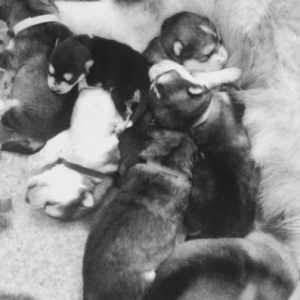Renal Dysplasia (Abnormal Kidney Development)

This is my experience of the condition.
We produced a litter in which was a puppy considerably smaller than the siblings but went on to catch up in size, ultimately it was health tested by our vet as fit and well to go to a new home. Then at 9 months this puppy was not eating well and began to lose weight, became quite lethargic and generally unwell. After a scan it was found that the pups kidneys were smaller than they should be with one misshapen.
After medication and an adjusted diet this pup has a promising prognosis.

This disorder is congenital (present at birth), but signs and symptoms may not be seen for many months so the puppy on leaving the breeder to its new home will most probably be a happy healthy puppy.
Symptoms
These are some of the more obvious symptoms, they can also be signs of other health issues so the best course of action is to seek veterinary advice. The dog will be thirsty and drink a lot producing large volumes of urine. Maybe have a decreased appetite. He/she may have difficulty in gaining weight and be small for their age with overall poor body condition, lethargy, dull coat , depression and slow wound healing. They may also suffer from vomiting and diarrhoea.
There are twenty breeds classified at risk of this disorder including the Alaskan malamute so certainly something to keep in mind when your dog becomes unwell with any of these symptoms.
What is Renal Dysplasia?
This is where a puppy develops an abnormality in one or both kidneys which, when scanned may appear small and misshapen.
Possible causes of the condition:
Bacterial or viral infection of foetal tissue
Canine herpes virus.
Exposure of the dam to toxins during the pregnancy.
Physical trauma to the foetus.
There is also a theory suggesting a genetic link but as yet this has not been proven.
Treatment
A blood test and scan is required to determine the condition and urine tests at regular intervals to asses and to monitor any deterioration. Affected dogs should be fed a low sodium diet to prevent water retention, and a high quality, low protein diet due to a poor metabolic rate, your vet may also wish to monitor phosphorus levels in the diet. These diets will need to be tailored to each individual depending on the severity of the condition. Free access to water is recommended.
Prognosis
Many factors need to be taken into consideration; the degree of kidney dysfunction, the age at the time of onset and how well it can be managed.
Unfortunately the prognosis is not good if both kidneys are affected, in most cases long term survival is poor. If one kidney alone is affected and the other is functioning normally he/she should be able to function with the single healthy kidney and a normal life span can be expected. Unfortunately most cases appear to be biilateral renal dysplasia.
Julie Whyman
Health Sub-Committee
2018
